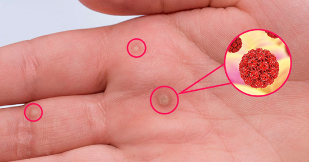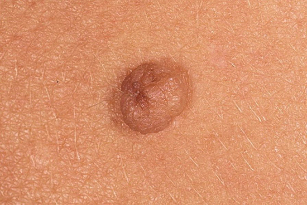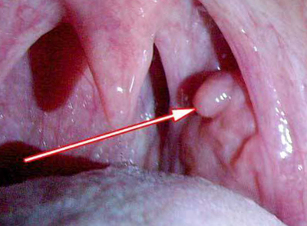
In this article, we will cover the following:
- what are papillomas;
- what is the reason for their formation.
- where they are more common in men and women;
- typical papilloma.
Papillomas are benign neoplasms located on the skin, in the mucosa. The reason for their formation is human papillomavirus (HPV), which is transmitted in different ways. The appearance of the formations depends on the type of virus that caused them.
Transmission paths
Human papillomavirus is transmitted by:
- During sexual intercourse, including anal, oral-genital.
- When working from mother to child.
It can be an autoinfection if the virus is transferred from one area of the body to another, which usually occurs when shaving, hair removal.
The incubation period (the period from the entry of HPV into the body until the onset of signs of pathology) varies from a few weeks to several years.
Papillomas in the body most often appear in case of illness, pregnancy, alcohol abuse, psycho-emotional stress, hypothermia, accompanied by a decrease in immune defense. The incidence of these formations in men and women is the same.

Human papillomavirus: species
Depending on the risk of skin oncological pathology, mucosal papillomaviruses belong to the following groups:
- Low oncogenic risk (HPV 3, 6, 11, 13, 32, 34, 72, 73, 40–44, 51, 61 species).
- Moderate oncogenic risk (HPV types 52, 56, 58, 30, 35, 45).
- High risk of malignant processes (HPV 50, 59, 16, 18, 64, 68, 70, 31, 33, 39 types).
Microorganisms with a low cancer risk cause benign growths on the skin, mucous membranes.
Types of papillomas
Simple

They are also called vulgar, ordinary. Such increases are most often caused by HPV types 26-29, 77, 63, 41.
Sensitive burning sensation appears on any part of the body. Later, the growth of a spherical formation is noted, the surface of which gradually becomes rough. At first, the tumor is flesh-colored, then darkens. The size of the papilloma on the body is from 1 mm to cm
These neoplasms are single, multiple. In the latter case, the daughter's small papillomas are located around the mother, forming first, usually the largest of all.
Their location is the back of the hands, fingers, the spaces between them, the chin area, the edges of the lips. There are such papillomas on the neck. The baby's knees are affected because children often crawl, becoming infected through small skin lesions.
plantar
People with these formations are infected with HPV types 1, 2, 4. The growths are similar to dry calluses, but have a number of characteristic differences.
The skin pattern is preserved on calluses, absent on the surface of papillomas, the latter being smooth. The formation caused by papillomavirus is painful, the uncomfortable sensations intensify when you wear squeezing shoes. Inside the papilloma, black dots are visible, which are missing in the calluses.
Neoplasms sometimes self-destructive, which is more common in children. Sometimes small blisters are visible around the neoplasm. The latter over time turn into new papillomas.

Flat papillomas
Growths of a round, elongated, oval shape, grow above the level of the skin by 1-2 millimeters. Flat papillomas are located around the mouth, face, and upper half of the body. Sometimes papillomas form on the neck.
There are data papillomas in the labia, cervix in girls, penis in men, in the rectum, near the anus. These formations are located in groups, joining each other. Flat-colored papillomas of the flesh, sometimes slightly darker than the rest of the skin, form under the influence of 10, 49, 28 papillomavirus species.
Threaded
If people notice that small papillomas have appeared on the neck, then most often the growths are in the form of fibers. The second name of the formations isacrochordus. The latter are caused by 2, 7 types of HPV.
In the initial stage, the papillomas on the neck look like small yellow seals, then the growths stretch, become rough, acquire an elongated, rounded shape, with similar threads. A distinctive feature of a similar neck papilloma is a slender leg.
Most often, the chord is formed in men, women over 40 years. Growths also occur on the skin of the upper eyelids, armpits, mammary glands, in the intimate area.
observed

Formation data are called warts,caused by human papillomavirus types 6, 11, 11, 44, 42, 54, 51, 55, 89 in women and men.
Condylomas are small, single, multiple flesh-colored results located on the female, male organs around the anus. There are papillomas in the vagina, labia minora, cervix. In men, warts are located on the forehead, at the head of the penis, inside the urethra.
Special elements sometimes merge with each other, a tumor-like formation appears, which resembles on the outside with a turkey comb, cauliflower. Neoplasms are characterized by very rapid growth, a large lesion can form within a few hours.
Pathology has a repetitive course. More severe with concomitant sexually transmitted infections of the urogenital tract (eg chlamydia, gonorrhea, mycoplasmosis).
Condylomas that form in the cervix, especially inside the cervical canal, are the most dangerous during pregnancy. Hormonal changes stimulate rapid growth, followed by tissue breakdown and secondary infections.
Papillomas in the mouth, larynx
Their appearance is associated with the activity of papillomaviruses 6, 7, 11, 72, 73, 57, 32 species. Formations are rounded formations on a thin or wide base. The mucous membrane around them is pale pink, without any noticeable pathological changes. The surface of the growths is pale pink, white.
Neoplasms are single, multiple, painless when pressed. They are located in the lower part of the oral cavity, the back of the tongue, the hard, soft palate, the laryngeal mucosa, the size varies from 2 mm to 2 cm.

Overload of the oral mucosa leaks if bitten, darkens as a result of bleeding into it. The state of health in the presence of such a disease does not deteriorate, the oral cavity opens freely.
When in a single adult growth are located in the soft palate, tonsils, in the glottis, there is a feeling of the presence of a foreign body, a cough, the voice becomes clumsy. If the lesions become numerous, these symptoms worsen.
In children, pathological growths are often bilateral, their onset is accompanied by the following symptoms:
- Difficulty in sucking, exhaling, arising after physical exercise, then at complete rest.
- Cough after running, play a lot.
- Choking attacks with stenosisof the larynx (pathological narrowing that prevents air from entering the lower respiratory tract).
The appearance of various external papillomas is associated with infection with different types of HPV. To remove neoplasms, you should consult a doctor. This should be done as soon as possible if the papillomas are multiple, rapidly increasing in size, causing discomfort, and persistent injury.














































































